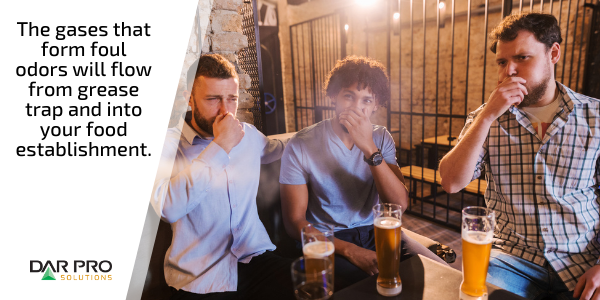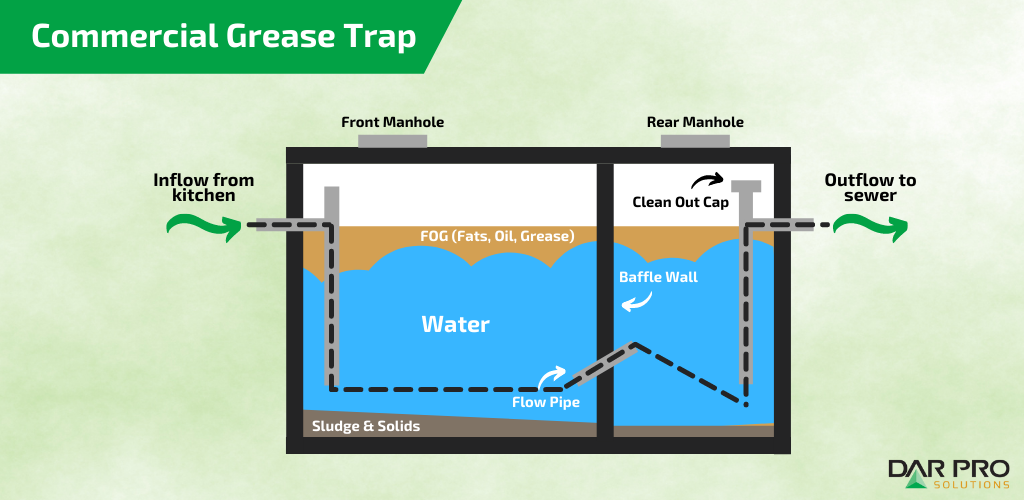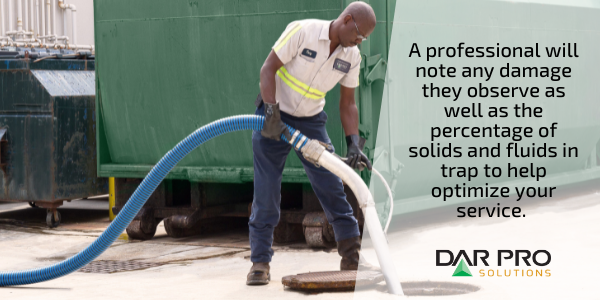1. Debris Going Down the Drain
Pouring used cooking oil and other food-related waste down the drain is a surefire way to end up with a grease trap issue. This improper practice is the gateway to the majority of other issues that related to grease traps such as slow drainage, clogs, overflows and foul odors. Trash, cooking oil and other debris should never be flushed down your drain and into your trap.

First and foremost, you should never let your hot used cooking oil end up in your drainage pipes. While it might seem no different than water, cooking oil hardens when it cools and will build up in your trap’s inlet or outlet pipe and almost certainly cause a clog. Make sure your staff is educated on the importance of properly discarding fryer int your storage bin. This is paramount to preventing grease trap issues. Think about it this way: your staff pouring oil is costing you money in multiple ways – it’s the cost that comes with clogs and backups that slow your kitchen operations, coupled with them pouring a valuable, recyclable commodity down the drain. No one wins when cooking oil is poured down the drain.
Here is what you do with it instead.
Other debris ending up down the drain might be less intentional, but the consequences of it are still the same. Food waste and trash belong in the garbage can, not your drainage pipes. A typical grease trap pipe is 4’’. That’s a lot of room for other debris such as solid food waste, gloves, napkins, forks, knives and other things found in a kitchen to end up down the drain. This can quickly lead to a clog and an expensive plumbing issue. Minimizing the amount of solid waste that ends up down the drain and into your grease trap is a great way to prevent issues.
“They really can eliminate most of their problems by having the floor drain covers, not putting cooking oil down the drain, as well as other debris like gloves and plastic straws,” Said Ken Thomley.
Employee best practices.
2. A Foul Smell
A strong odor coming from around your grease trap is an indicator that there could be an issue with the trap. The fats, oils and grease degrade the longer they sit in there and will eventually lead to a foul odor if left unattended. Why? Because bacteria eventually breaks down the solidified material, causing it to spoil and emit a foul odor. Additionally, if the opening of the trap gets covered or clogged, the gases that form foul odors will flow wards from grease trap and into your food establishment from outdoors. Once that occurs, it then becomes an issue that affects your customers as well as your staff, and no one wants that.

Cleaning your grease trap regularly is important to ensure bad smells don’t form and your trap continues to function as intended. If you are already doing this, it’s worth nothing that a foul smell could form immediately after the trap is cleaned. This is normal and not a sign of a problem. The smell will subside as water fills back up into the trap.
If your business does not do regular grease trap cleaning, it will lead to a rotten smell in the kitchen and dining area and could eventually lead to more serious issues like a clog or an overflow.
3. Slow Drainage

If you notice if the sink or other drainage areas in and around your kitchen are draining slowly, you might have a problem with your grease trap. More specifically, you might have a clog forming from solid food waste or other debris that has found its way into your drainage pipes and eventually your grease trap. When the fats, oil and grease that your grease trap catches solidify, it eventually begins to build up and slows down the water flow to and from the trap. If your trap is functioning as it is supposed to, then your drainage shouldn’t be slowed at all – unless the trap is full. If water is draining slowly from your sink or elsewhere, you likely have a problem.
If you happen to notice this, it’s important to act swiftly. And depending upon where the clog is located – either in one of the inlet our outlet pipes, or the trap itself – you might need to call a plumber in addition to your grease service provider to have the trap cleaned. Keeping a keen eye out for slow drainage is important. You don’t want the problem to turn into a larger issue like an overflow.
4. Inlet, Outlet or Barrier Wall Clog
Speaking of a clog, you need to know where exactly it has formed. In order to do that, it’s important to know how your grease trap functions.
How your trap works
The grease trap itself, also known as the grease trap proper, holds all the waste that goes down your drain. Your trap is connected to an inlet pipe through which all the waste that goes down your drain flows through into the trap. The outlet pipe is located on the other side of the trap and funnels the liquid waste into your municipality’s sewer system. In the middle of those two is a baffle barrier. It traps the grease and prevents it from going out the outlet pipe, while allowing the water to escape through that very same outlet pipe with the solid waste settling to the bottom of the trap.

Not all traps are the same
While most grease traps reside outside your building and are protected by a manhole cover, some businesses have indoor grease traps located underneath a kitchen’s sink. These under the sink traps are smaller, and therefore more likely to have an issue arise because of the smaller capacity. If your business has an indoor grease trap and you’re having problems with it, it may be worth the cost to install an outdoor trap.
Why the clog’s location matters.
If there is a clog in your inlet pipe, it will eventually lead to a backup and an overflow in your kitchen. The same goes for the outlet pipe, but it will likely surface around your trap in your parking lot. If a clog forms in either one of these and not in the trap itself, you are best suited to call a plumber rather than your service provider fixing the issue.
If the issue is in the trap itself, perhaps in the opening around that barrier that allows water to flow through, then you need to call your service provider to have your trap cleaned and pumped immediately before it becomes and even more severe problem.
5. An Overflow
Lastly, the most obvious sign you have a grease trap issue is that you notice an overflow. This could be grease itself escaping through the manhole cover in your trap or a backup in your kitchen. An overflow means the problem has already gotten fairly severe and you’ll likely need assistance from a plumber or your provider to rectify the issue.
Grease spills are tricky messes to clean up. There is a specific way to handle them, and if done correctly, you can mitigate the spread of an overflow until a plumber, or your service provider arrives.
Being mindful of spotting potential issues with your grease trap is important. You don’t want a major issue to occur that slows the productivity of your business. It’s also crucial that you have your grease trap regularly serviced by a reputable provider. This is the best way to ensure it continues to function as it is supposed to.

6. Insufficient Service
As important as it is to have your grease trap regularly serviced, who you partner with matters as well. Your grease trap service provider should keep you in compliance with your municipality's regulations. Different municipalities have varying requirements on water level, frequency of service and other things. If your water level is not in compliance, it could lead to a fine or potentially an overflow or a backup in your grease trap. When grease and other waste comprise more than 25 percent of your wastewater level in the trap, it means it is time for your trap to be serviced.
When your provider arrives to service your grease trap, they are typically checking to see if the t-pipe is intact and isn’t damaged. They will note any damage they observe, as well as the percentage of solids and fluids in the trap. This will help optimize your service. The percentage of waste in the trap helps your provider know whether your trap needs to be serviced more or less frequently, which in turn will make the service they provide better for your business. Who you partner with matters. Make sure your provider’s service is up to par.
DAR PRO Solutions provides grease trap maintenance service for businesses across the country. Our program keeps your grease trap operating smoothly and keeps you compliant with all regulations. Reach out to a DAR PRO representative today and find out how your business can benefit from our program. Call us 24/7/365 at 855-DAR-PRO1 (855-327-7761).
Contact Sales
For customer service inquiries call our toll free number (855) 327-7761
By submitting this form I agree to the privacy policy including the usage of contact details to contact me for marketing purposes.
